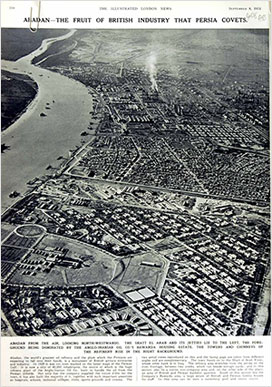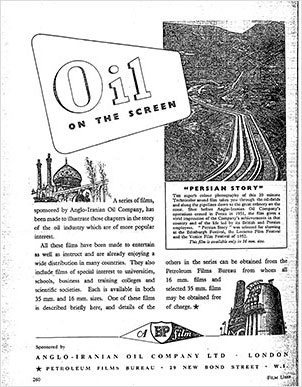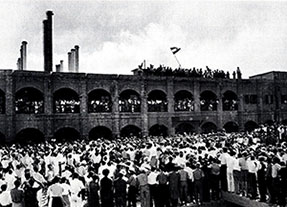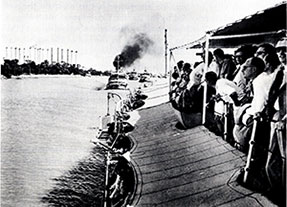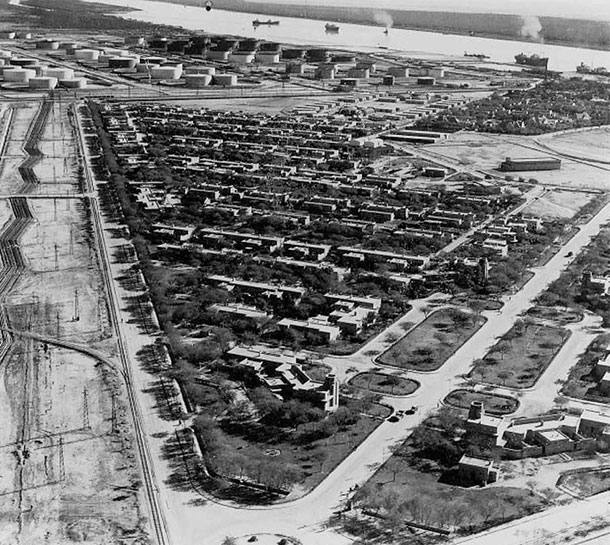Documenting the Modern Oil City:
Cinematic Urbanism in Anglo-Iranian’s Persian Story
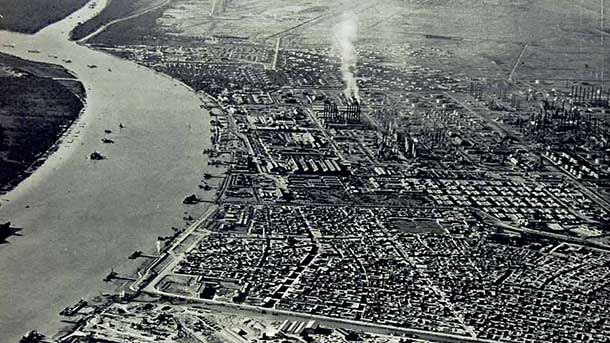
Mona Damluji
University of California, Berkeley
In 1951, the Anglo-Iranian Oil Company (AIOC) described its documentary film Persian Story as “the first sympathetic portrayal of Iran ever made for a public audience,” and one of the most important publicity projects the company had ever undertaken.1 The film would excite audiences at home with a glimpse of life in the oil company town of Abadan, adjacent to the site of AIOC’s most productive refinery in Iran [Figure 1]. A 1953 advertisement for Persian Story [Figure 2] describes the film as one that “gives a vivid impression of the Company’s achievements in that country and of the life led by its British and Persian employees.”2
However, the behind-the-scene details of the oil company’s production of Persian Story reveal a far more complicated and intriguing story. Almost as soon as filmmakers had started shooting on location in Iran in 1951, discontent among oil workers regarding the conditions imposed by AIOC had reached its peak. By April, the movement led by Prime Minister Mossadegh to nationalize Iran’s oil industry culminated as deadly strikes at the Abadan refinery and related protests swept across major cities [Figure 3]. By the end of the summer, AIOC evacuated all British employees from the oil city and the company’s operations were turned over to the newly created National Iranian Oil Company [Figure 4].
Persian Story was planned before the nationalization of the oil industry in Iran, shot before and during the uprisings, and edited and circulated afterward. This paper considers how Persian Story informs a critical understanding of modernization in Abadan during this politically volatile period in Iran’s modern history. Specifically, it examines how cinematic devices used in the final cut of the film worked to selectively highlight or hide spaces and processes of the modern city to suit AIOC’s political needs. As the most widely circulated cinematic portrait of Abadan as it was under full AIOC administration, Persian Story offers an exceptional opportunity to examine how the oil company attempted to shape perceptions of modernity in the city, on the screen and on the ground.
More broadly, Persian Story serves as an important case study of the politicization of oil company films and the space of oil cities. Oil company films can be read both as a text and as a set of practices shaped by the need to legitimize the work of an extractive foreign company, and thus privilege particular readings of oil cities and modernity. As author Mark Shiel observed in Cinema and the City, methods for examining the relationship between cinema, urban space, and society must “[undermine] the reifying tendency to speak of cinema simply in terms of the text and its reflection of urban and social change ‘on the ground.’”3 Instead, we must “[foster] an understanding of cinema as a set of practices and activities, as well as a set of texts,” and “as something which never ceases to intervene in society, and which participates in the maintenance, mutation, and subversion of systems of power."4
Similarly, in Cinematic Urbanism, AlSayyad emphasizes that our lived experiences of the modern city cannot be understood independently from our cinematic experience of the city.5 AlSayyad points to the need for scholars to go beyond the examination of how films work to capture or depict society “as they really are” and rather account for the ways in which films influence how we construct and perceive the world and, as a result, how we operate within it. Building upon Shiel and AlSayyad’s provocations, this paper aims to provide a better understanding of how perceptions of oil cities have been shaped through the production and circulation of oil films in Europe and the Middle East.
Cinema and the Oil City
Until now, the collection of Anglo-Iranian Oil Company films held by the British Petroleum Video Library in London has been largely overlooked by scholars, despite the fact that these were among the earliest documentary films made in and about the Middle East to be circulated to mass audiences worldwide.
Filmmaking technologies had been introduced to the Middle East largely as a result of British and French colonialism after World War I. From the 1920s and over subsequent decades, trained and amateur foreign and local filmmakers shot footage of the region in the interest of corporations, government agencies, political organizations, news agencies, and individual interests. In the 1940s, the pioneers of the British Documentary Film Movement initiated a campaign encouraging British industries to make “factual” films for public consumption and establish public relations divisions within their companies. It was at this point that British petroleum companies based in the Middle East invested in documentary films about the region for both theatrical and non-theatrical distribution in Europe, North America, and the Middle East.6 AIOC established a special branch dedicated to overseeing the production and distribution of documentary films in 1948.
By the 1950s, corporate sponsorship of documentary films had become common practice for oil companies, as they were convinced that cinema was the ideal vehicle for public relations campaigns to bolster positive perceptions of the companies’ extractive postwar activities in the Middle East and elsewhere. The scope of oil films made in and about the Middle East addressed a vast range of themes and tropes, from archaeology and agriculture to sports and technology. Shell and AIOC were leaders in the production of oil films that were screened for stockholders and company staff, and also circulated through public cinemas in London and international film festivals throughout Europe. The Petroleum Film Bureau in London was established to provide non-theatrical distribution of oil films to grade schools, colleges, film societies, and special interest clubs. The Iraq Petroleum Company also established its own in-house film unit based in Baghdad. By 1956, in addition to circulation in theatres and festivals, non-theatrical distribution had climbed to 78,000 oil films borrowed in that year alone.7
The Anglo-Iranian Oil Company’s Persian Story
AIOC never made direct advertising films to draw consumers to the gas pump or sell a new lubricant; rather the oil company insisted on making “factual” films for the purpose of documenting and educating the public about the oil industry, and in particular what it claimed were its positive effects on developing countries abroad. Moreover, AIOC oil films were made for English-speaking audiences in Europe. However, company films were seen all around the world.8
For almost two years, between March 1949 and January 1951, AIOC officials in London bounced around ideas for a documentary film centered on daily life in Abadan. From the outset, Ronald Tritton, director of AIOC’s public relations office, conceived of the film as a lively portrait of Abadan, the refinery and adjacent company town. His objective was to create a film that reflected what he saw as the “real” atmosphere of the place:
The film might start at midnight in the Refinery itself [with] something full of noise and steam and heat to set the scene. This noisy production sequence could give way to the quiet of a hospital ward in the early hours with an English nurse soothing an ill and frightened Iranian girl. From there we might go, say at 5am to the dairy farm and the comfortable homely noise of milking cows. […] Do you see what I am getting at? Through the day, sequence can fade into sequence … The whole thing would have the Refinery as its backcloth and the rhythmical pumping of oil as its musical theme—the real heartbeat of Abadan.9
In 1951, just as the London-based film production unit (Greenpark Productions) began to shoot on location in Iran, increasing discontent about labor conditions among oil workers reached a peak. From the beginning of production, AIOC’s British film crew faced obstacles that affected their ability to follow the intended shooting script. These obstacles ranged from troubles with equipment and transportation to issues of government censorship. The film production was cut short when a movement by Iran’s Prime Minister Mohammed Mossadegh inspired widespread strikes at the Abadan refinery and in major cities across Iran. By October the movement culminated in the evacuation of British oil company employees and the nationalization of the Iranian oil industry.
AIOC screened the final cut of Persian Story in London for mass audiences well after the oil industry in Iran had been nationalized. For the film premiere, “the biggest film party ever given in Europe was organized” for audiences totaling more than 11,500 in seven large West End cinemas in the British capital [Figure 5].10 The film continued to enjoy theatrical and non-theatrical distribution with extremely positive reviews, and was selected by the Venice, Locarno, and Edinburgh film festivals in 1952.11 As the only documentary film to portray Abadan before the British evacuated in August 1951, Persian Story garnered exceptional status as a surviving portrait of the Westernized Iranian oil city that ceased to exist after it was taken over by Iranian radicals.
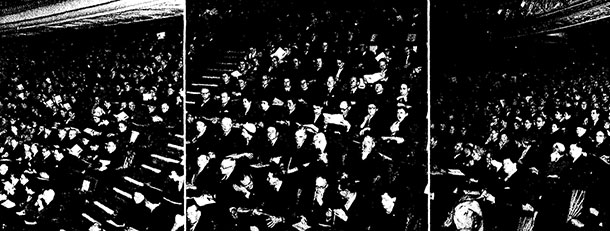
Figure 5. View larger | View in new window
However, Persian Story ultimately fails to reconcile the incongruity of its harmonious image of Iranians living in the modern oil city of Abadan and the degrading conditions that the company subjected workers to for decades.
Urban Modernity in Abadan: Reel versus Real
The AIOC’s filmmakers constructed the viewer’s experience of Abadan through a montage of sequences and a dynamic soundtrack that convey the impression of bright modern spaces and a harmonious society. Looking more closely at the visual sequencing, framing, pacing, and composition, one can analyze how the modern city is selectively and strategically constructed in virtual space.

Video clip and permissions courtesy of British Petroleum Video Library. Watch video | View in new window
The initial sequence depicting life in Abadan introduces viewers to the street level of the oil city. The shot moves along a bustling urban thoroughfare where locals walk, shop, and lock eyes with the camera as it passes. The photographer’s distance from the scene and the quick-paced camera movement directs the viewer’s eye to focus on large objects centered in the frame before they pass, such as colorful market stalls and shiny modern cars parked along the sidewalk. Iranian men dressed in European-style suits stand out against surrounding pedestrians in street clothes. The movement of the tracking shot is so fast-paced, in fact, that darker details at the edges of the frame are likely to slip from the viewer’s attention. Focusing on a still frame from the sequence, one can see that this local street in Abadan suffers from badly maintained roads and dilapidating building construction. It is important to note that at no point does the narrator locate this continuous shot sequence within the context of the rest of the city.
The subsequent montage consists of steady and slow panning shots, in which the camera fixes its frame, lingering on subjects set in the garden of a large bungalow house, and a lush landscape of palm trees where two Iranian women stroll through the scene, pushing prams and wearing recognizably European-style dresses and hairdos. The scene is set in a quintessential European garden suburb, yet one located in the desert of Iran. If not for a brief moment in which the camera catches the smokestacks of one of the world’s largest oil refineries in the background, the long visual sequence of Abadan otherwise renders invisible the atmosphere of industrial machinery, pollution, and noise that constantly looms over these spaces in reality.
In Persian Story, modernity in Abadan is constructed as a blatant mimicry of European modernity, or in other words a condition dependent upon a European model, provided in this case by the British oil company. Modern spaces in the Iranian oil city represent material evidence of a modern way of life comprising immediately recognizable symbols: the large single-family home, the automobile, the garden, the tailored dress, and the two-piece swimsuit. The film’s tightly constructed montages featuring static spatial and social environments do not reveal any dynamic or problematic aspects of modernization in Iran and more specifically do not begin to address the elephant in the room: the troubled relationship between the oil company and Iranian employees in Abadan.
Living conditions for most of AIOC’s non-British oil workers were extremely poor. The majority did not receive formal housing provisions and were left to live in “slum”-like environments on the periphery of the refinery [Figure 6]. Manucher Farmanfarmaian documents that at the time for most refinery workers, “Wages were 50 cents a day. There was no vacation pay, no sick leave, no disability compensation. The workers lived in a shanty town … without running water or electricity.”12
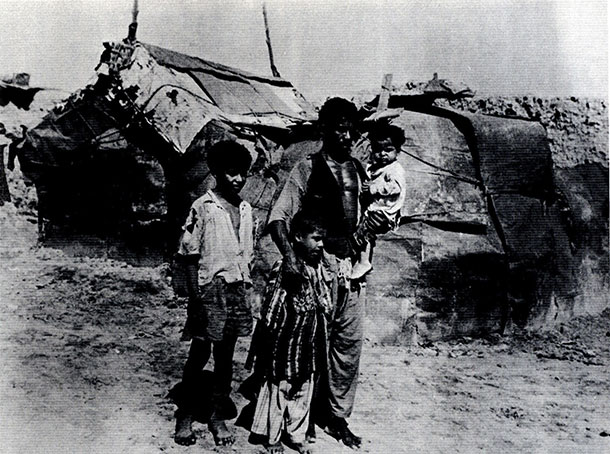
Figure 6. View larger | View in new window
The experience of Iranian laborers differed entirely from that of the British administrative personnel and technicians, and of a minority of Iranians hired for more technical positions or married to British staff. This latter group lived in a planned garden suburb pictured in Persian Story and known as Barwada. AIOC’s chief architect planned and built this neighborhood in the late 1940s as an experimental integrated residential area in the otherwise spatially and socially segregated oil city [Figure 7]. In this garden suburb, selected non-European staff could live side-by-side in the same bungalow-style homes that Europeans had occupied in specially planned and isolated neighborhoods since the 1920s.
As a critical study by the architectural historian Mark Crinson has demonstrated, Barwada was the exception and not the rule for Abadan’s Iranian residents.13 The integrated plan for Barwada was unprecedented, and all other living quarters for the Iranian workforce were segregated from those occupied by the company’s British employees. Crinson details that from early settlement until the 1950s, European staff lived in isolated bungalow areas mainly to the west of the refinery with their own system of buses, markets, cinemas, clubs, and so forth. To the east of the refinery, Iranian AIOC laborers were left to settle informally in a densely populated town with little services and infrastructure. Although some company housing was provided for Iranian staff, the great majority of company resources was poured into European staff housing.14 By 1951, when Abadan had more than 200,000 inhabitants (of which 65,000 were company employees), less than 20 percent lived in the planned residential districts where the AIOC provided housing.
Crinson’s critical analysis of Abadan’s spatial development informs a particular reading of the film. Persian Story pairs together selective footage depicting the manicured garden suburb and the street running through the town center to suggest that these spaces somehow blend together. It does not examine or explain how these spaces relate to one another and how their respective inhabitants are kept apart and socially segregated in their everyday lives. Persian Story privileges the story of everyday life in the exceptional space of the garden suburb, situated in the context of the broader city without any indication of the social and spatial barriers that define Abadan. Ultimately this depiction serves as a means for the company to popularize the idea that, in addition to extracting oil, AIOC played a civilizing role in Iran: as the harbinger of Western notions of modern spatial order and social conventions.
By privileging the visual narrative focused on the suburb over the spaces of the city where most Iranian workers lived, the film spotlights the intervention of utopian garden city design while otherwise ignoring the broader context of change and the problems the company encountered in accommodating Abadan’s booming population of laborers. As suggested by the turbulent events of 1951, the utopian experiment in the Barwada suburb failed to ease the greater underlying tensions of urban segregation and inequality on the ground. Yet the portrait in Persian Story of Abadan as a harmonious garden city was impressed upon the tens of thousands of people outside of Iran who watched the film as a “factual” documentary account.
Conclusion
Cinema is a critical lens through which urban historians can investigate how the social and spatial dimensions of cities have been constructed. As visual documents of urban transformation, the oil films produced by AIOC profile modernization projects at a critical point in Iran’s modern history. Oil company officials claimed that they were working to create “the first sympathetic portrayal of Iran ever made,” yet in reality the company constructed a false representation that only served to reinforce the link between modernization and oil extraction. In Persian Story, modernity in Abadan is equated to a material social condition contingent upon the presence of the British oil company. AIOC’s film about Abadan premiered to thousands of viewers as a portrait of modern life in the oil city. However, the documentary provided a very limited and skewed narrative of the ways in which Iranians really lived, the spaces they occupied, and how they participated in the making of the oil city.
Persian Story was the first oil film to attempt to explicitly represent how Iranians experienced life in Abadan. It served as a precedent for similar cultural projects carried out by oil companies in the region, such as the Iraq Petroleum Company, and ARAMCO in Saudi Arabia. AIOC’s Persian Story should not be dismissed merely as an example of propaganda, but rather viewed in terms of a set of discourses, choices, images, and practices related to the oil city. In attempting to control the image of the Iranian experience in Abadan, the film circulated among theatrical and non-theatrical distribution circuits around the world as a visual narrative that responded to the sociopolitical moment in which it was produced. When examined in context of current understanding of the modernization of oil cities, we can see how oil films worked to privilege certain spaces and processes while rendering invisible more critical questions about the problems and consequences of urbanization. In this sense oil films are inextricably tied into the same relationships of power and representation that were shaping the cities on the ground. Ultimately, it can be said that this project of filmmaking was critically embedded in the larger enterprise of oil development, shaping discourses on modernity and the city.
Figure Credits
Figure 1. “Abadan—The Fruit of British Industry that Persia Covets.” The Illustrated London News (September 8, 1951), 358.
Figure 2. Film User (January 1953), 260.
Figure 3. Bamberg, J.H. The History of the British Petroleum Company: The Anglo-Iranian Years, 1928–1954. Cambridge University Press, 2006: 426.
Figure 4. Bamberg, J.H. The History of the British Petroleum Company: The Anglo-Iranian Years, 1928–1954. Cambridge University Press, 2006: 457.
Figure 5. Petroleum Times (January 9, 1953).
Figure 6. Bamberg, J.H. The History of the British Petroleum Company: The Anglo-Iranian Years, 1928–1954. Cambridge University Press, 2006: 448.
Figure 7. Crinson, Mark. “Abadan: Planning and Architecture under the Anglo-Iranian Oil Company.” In Planning Perspectives 12:3 (1997). [Photo by Wilson, Mason and Partners]
2 “Oil on the Screen,” In Film User (January 1953), 260.
3 Shiel, Mark, and Fitzmaurice, Tony. Cinema and the City: Film and Urban Societies in a Global Context. Oxford; Malden: Blackwell, 2001: 4.
4 Ibid, 3–4.
5 AlSayyad, Nezar. Cinematic Urbanism: A History of the Modern from Reel to Real.New York: Routledge, 2006: 1–3.
6 Adams, Elena. “BP Archive History.” Unpublished paper, BP Video Library, 2008: 1.
7 Tritton, Ronald. “How We Use Films: At Anglo-Iranian.” In Film User (September 1953), 465.
8 Ibid, 464–65.
9 Tritton, Ronald. “Film about Abadan.” March 9, 1949, 183091 BP.
10 Tritton, 465; “The Anglo-Iranian Co.’s Film Show: Past and Present Portrayed to a Great Audience.” In The Petroleum Times (January 9, 1953). 35516 BP.
11 Ibid.
12 Farmanfarmaian, Manucher. Blood and Oil: Inside the Shah's Iran. Modern Library, 1999: 184–85.
13 Crinson, Mark. “Abadan: Planning and Architecture under the Anglo-Iranian Oil Company.” In Planning Perspectives 12 (1997): 347–57.
14 Ibid., 342–46.
Mona Damluji is a doctoral candidate in architecture at the University of California, Berkeley. Her dissertation examines intersecting histories of oil, urban development, and cinema in the Middle East.
"Cinematic Urbanism" is an online component of Ars Orientalis 42, published October 2012.

